Luftwaffe Group Build: Roden 1/48 Arado Ar 68F-1
The Airplane:
Following the 1932 success of the Ar-65 as the airplane that would become the first fighter of the re-born Luftwaffe, Arado commenced work on two diferent prototypes of successor fighters, the Ar-67 and AR-68. The Ar-67 was dropped when the Luftfahrtkommissariat determined it did notr offer a sufficient advance over the Ar-65 to merit continued development. The Ar-68 was a larger and heavier design. With the assurance of the Luftfahrtkommissariat that the new Jumo 210 powerplant would be ready for installation in production fighters in 1935, the fighter was designed for this engine. Development received low priority since the He-51 had been chosen as the Ar-65 successor. Construction of the prototype D-I KIN commenced in the late summer of 1935 and it first flew in June 1934, powered by the BMW VId engine.
The prototype was successful from the outset in terms of handling and maneuverability, though speed and climb were only marginally better than the Ar-65 due to retention of the lower-powered engine. The new Jumo 210 was installed in the second and third prototypes, the Ar-68b D-IVUS and Ar-68c D-IBAS, the first armed prototype, that joined the flight test program in April and June 1935 respectively. The Jumo 210 was supercharged and could maintain sea level power to 9,000m.
Arado expected an order for the new fighter in 1934, but the Luftwaffe fighter units, whose pilots had been trained on the docile and forgiving Ar-65 and were now experiencing difficulty transitioning to the more temperamental He-51. Since the Ar-68 was even more highly loaded and offered even higher approach speeds, it was felt that it did not improve on the He-51.
Ernst Udet, newly appointed as Inspector of Fighters and Dive Bombers, had flown the prototypes and considered the performance of the airplane to be a vast improvement over the He-51, which he believed did not demonstrate that “if it looks right, it is right.” In 1936, he organized a mock combat between himself in the Ar-68c and one of the Luftwaffe's most experienced pilots in an He-51. Shortly after takeoff, the outcome was no longer in doubt, as Udet effortlessly out-climbed, out-turned and generally outfought the Heinkel fighter. While the Arado was no faster than its opponent, the fighter excelled in maneuverability. With that, the Ar-68 was ordered into production.
While Arado was planning production of the Ar-68E with the Jumo 210Da with a two-speed supercharger, the Reichluftfahrtministerium (RLM)determined priority use of the Jumo engine should go to the new Bf-109 fighter, and the first series Ar-68 would use the older BMW VI 7,3A engine as an interim measure. This was designated the Ar-68F-1 and entered squadron service in 1936, eventually serving replacing the He-51 in the Jagdgruppen. While this version of the fighter had similar performance to the He-51, it had the same maneuverability as the Jumo-powered prototype, making it more effective. After only some 180 Ar-68Fs had been produced, the fighter was reassigned priority for the Jumo 210Da and production finally switched to the Ar-68E-1, which became the Luftwaffe's last production biplane fighter.
The Ar-68F and the later Ar-68E equipped seven new Jagdgruppen before replacement began in the spring of 1938 with the arrival of the Bf-109B. The last Ar-68Fs became advanced trainers in the Jagdfliegerschulen.
The Kit:
There has been one Ar-68F kit released in 1/48 before this kit from Roden, the Classic Airframes kit, released around 2001, was a limited-run injection plastic kit. Having now built both, I can say that, of the two, this Roden kit is vastly superior to the earlier release from Classic Airframes.
Roden released this Ar-68F earlier this year. It is fully up to modern high-end limited-run kit quality. The one place the kit falls down is with decals, which are of poor quality. They provide markings for a pre-war airplane in the colorful markings of JG 135, an all-red airshow airplane, and a camouflaged trainer. I replaced the kit decals with some from the Aeromaster “Birth of the Luftwaffe' series, since the He-51 markings in those sheets are also applicable to Ar-68Fs.
Construction:
Quality wise, this kit is equal to the Roden 1/48 He-51B I reviewed back in 2016, and is about as difficult to construct - in other words, pretty easy.
I assembled the cockpit and painted it RLM02. I used some Eduard seatbelts to enhance the look. I glued the side flaps in the up position on the fuselage halves, since the small cockpit opening meant I didn't have to do more detail to the cockpit.
The engine cowling is separate. I glued each side half to its respective fuselage half so I could work the fit from inside and out. I glued the upper part on after I assembled the fuselage.
There are no locating pins and holes for assembling the fuselage, but if you take care with fitting the halves here, you won't need to do more than scrape down the fuselage centerline.
The gear legs fit easily and I opted for the streamlined gear.
The tail surfaces were next. I posed the elevator down.
The lower wings were assembled with the flaps up in the neutral position. It's important when gluing the wings to the fuselage to get the proper dihedral - which is zero.
Painting and Decals:
I painted the areas of white fore and aft on the fuselage, masked them, then preshaded the model with black along panel lines ane ribs, and painted the upper fuselage and nose black for the JG 131 scheme.white wingtips and rudder. I masked those off and gave the model an overall coat of RLM63, which I mixed from Tamiya “Buff” and “RLM Grau.” When all was dry, I gave the model a coat of MicroScale “Gloss.” The Aeromaster decals went on without problem.
Final Assembly:
I glued the cabane struts in position. Once they were set up, I positioned the upper wing on them to get proper positioning of the interplan “N” struts and glued them to the lower wing.
The simple interplane rigging was done with .03mm steel wire.
I then attached the prop and the windscreen.
Overall:
To my mind, the Ar-68F will never win a fight for looks with the He-51B, but the record is the real thing could take the Heinkel fighter in any fight. The airplane is historically significant as the last produced Luftwaffe biplane fighter and thus deserves a place in any comprehensive Luftwaffe collection. As a biplane model, this is an easy one without a lot of rigging, so it's sure to please those who are hesitant about biplane kits who want the model in their collection. In fact, it would be a good “first biplane” for a modeler. Highly recommended for overall quality and accuracy.
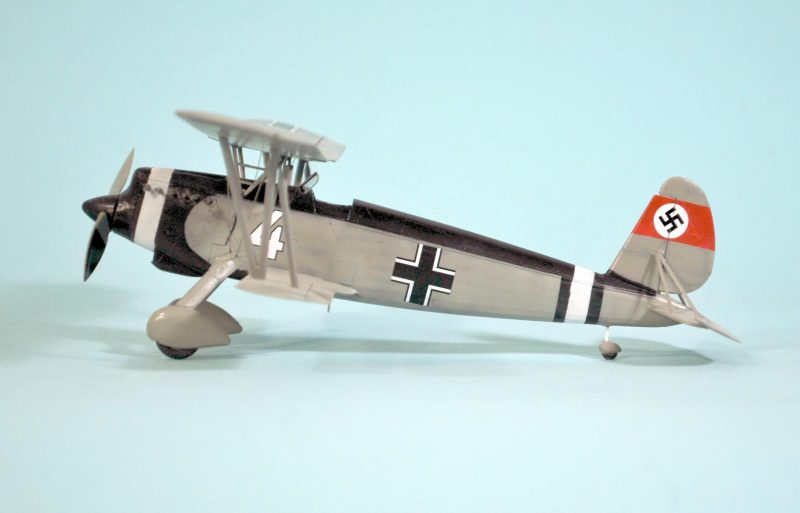
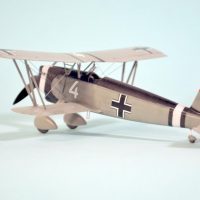
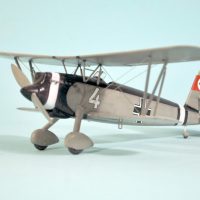
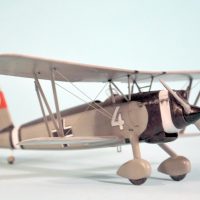
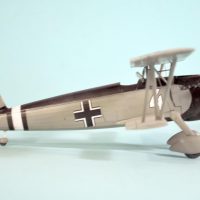
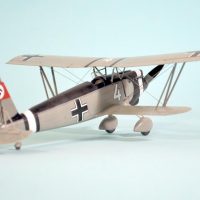
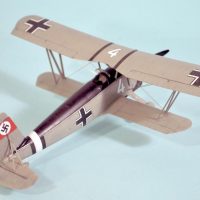

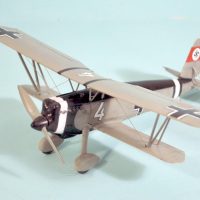
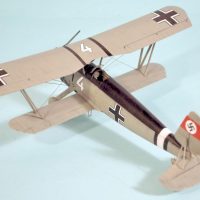
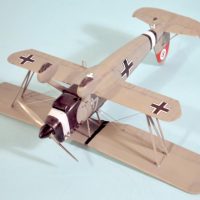
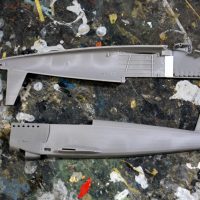
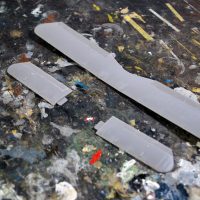
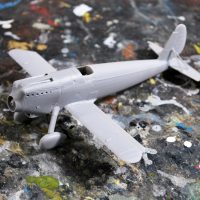
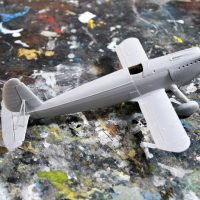
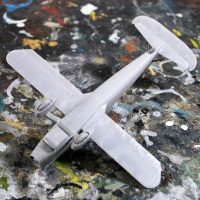
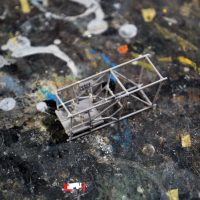
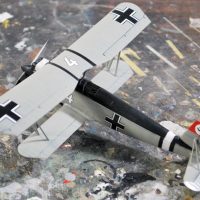
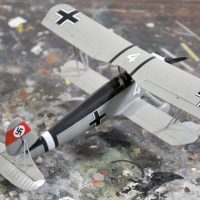
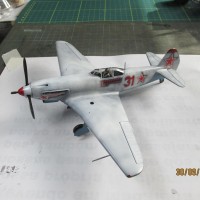
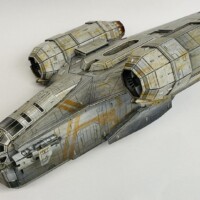
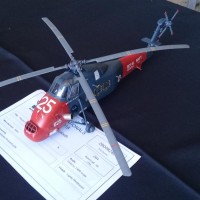
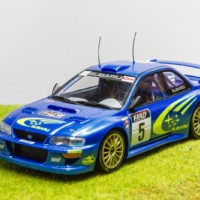
I love everything about this one. What a clean build, Tom!
A wonderful build Tom. I have always loved the late era biplanes that seemingly bridged the gap between the "kites" of the Great War and the monoplanes that followed. Thus far, I've only built a Hawker Fury (ex-Lindberg/Impact kit) and have the CA Ar-68, CA He-51, CA Cr-32, I-15, Bristol Bulldog (Impact), Gladiator(Impact) and Curtis Goshawk(Impact) in the stash. Candidly, those Classic Air kits intimidate the cr*p out of me! I'm happy to hear that much better versions are out there; perhaps it's time to put my CA kits up for sale if there are any takers, 😉
Thanks for the review and the look at your model! 🙂
Yeah, Roden does the Ar 68E and 68F, both of which beat the daylights out of the CA kits on ease of build and accuracy. Ditto their He 51. Special Hobby does the I-15 (which might be the CA kit) and ICM does a really nice 1/48 I-153. AMG does the Hawker Hart, which is one of the best kits I ever ran across.
I took a peek at the stash and yes, the I-15 is the Special Hobby kit. And I forgot I had the FineMolds Ki-10 II. That one looks like a very nice kit. 🙂
Yeah, just after I posted, I said to myself, "self, you forgot the Ki-10!" It is good.
The I-15 is one of the best kits Classic Airframes/Special Hobby did.
Great work on this Tom.
Great looking pristine finish Tom. As always I have learned from the background info.
Great work Tom, @tcinla, the prewar luftwaffe offers some cool opportunities. I really like the scheme, it looks perfect. Hope to see some of your work in Vegas in August.
Not gonna happen for two reasons - Las Vegas IPMS is run by a a set of rules I don't agree with (not to mention I can't stand Vegas, particularly in August - what were they thinking?) and caregivers don't travel.
Beautiful work on this build, Tom
Arado did develop some nice planes before and during the war.
Loved both model and article, Tom!
Ah - here's an aircraft I wasn't really aware of! I see there are 1/72 kits available, so may have to add one to the stash. Nice build Tom.
I love the obscure interwar planes. There are so many of them and not usually covered. Tom lifted the veil of darkness once again!
Nicely done! It's a great looking biplane.
Nice job on your build it really looks great! It was a pretty interesting time on the final bi-planes that existed then.